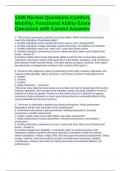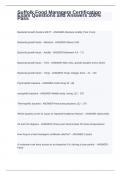1430 Review Questions Comfort,
Mobility, Functional Ability Exam
Questions with Correct Answers
1. The nurse is assessing a patients functional ability. Which activities most closely
match the definition of functional ability?
a. Healthy individual, works outside the home, uses a cane, well groomed
b. Healthy individual, college educated, travels frequently, can balance a checkbook
c. Healthy individual, works out, reads well, cooks and cleans house
d. Healthy individual, volunteers at church, works part time, takes care of family and
house - Answer-D
(Functional ability refers to the individuals ability to perform the normal daily activities
required to meet basic needs; fulfill usual roles in the family, workplace, and community;
and maintain health and well-being. The other options are good; however, each option
has advanced or independent activities in the context of the option.)
6. The term body alignment refers to positioning of the joints, tendons, ligaments, and
muscles while standing, sitting, and lying. A term that is similar to body alignment is
a. Weight.
b. Posture.
c. Friction.
d. Body mechanics. - Answer-B
(The terms body alignment and posture are similar and refer to positioning of the joints,
tendons, ligaments, and muscles while standing, sitting, and lying. Weight is the force
exerted on a body by gravity. Friction is a force that occurs in a direction to oppose
movement. Body mechanics is a term used to describe the coordinated efforts of the
musculoskeletal and nervous systems.)
2. The nurse is assessing a patients functional performance. What assessment
parameters will be most important in this assessment?
a. Continence assessment, gait assessment, feeding assessment, dressing
assessment, transfer assessment
b. Height, weight, body mass index (BMI), vital signs assessment
c. Sleep assessment, energy assessment, memory assessment, concentration
assessment
d. Healthy individual, volunteers at church, works part time, takes care of family and
house - Answer-A
(Functional impairment, disability, or handicap refers to varying degrees of an
individuals inability to perform the tasks required to complete normal life activities
without assistance. Height, weight, BMI, and vital signs are physical assessment. Sleep,
energy, memory, and concentration are part of a depression screening. Healthy,
volunteering, working, and caring for family and house are functional abilities, not
performance.)
,3. The nurse is assessing a patient with a mobility dysfunction and wants to gain insight
into the patients functional ability. What question would be the most appropriate?
a. Are you able to shop for yourself?
b. Do you use a cane, walker, or wheelchair to ambulate?
c. Do you know what todays date is?
d. Were you sad or depressed more than once in the last 3 days? - Answer-B
(Do you use a cane, walker, or wheelchair to ambulate? will assist the nurse in
determining the patients ability to perform self-care activities. A nutritional health risk
assessment is not the functional assessment. Knowing the date is part of a mental
status exam. Assessing sadness is a question to ask in the depression screening.)
4. The nurse is developing an interdisciplinary plan of care using the Roper-Logan-
Tierney Model of Nursing for a patient who is currently unconscious. Which
interventions would be most critical to developing a plan of care for this patient?
a. Eating and drinking, personal cleansing and dressing, working and playing
b. Toileting, transferring, dressing, and bathing activities
c. Sleeping, expressing sexuality, socializing with peers
d. Maintaining a safe environment, breathing, maintaining temperature - Answer-D
(The most critical aspects of care for an unconscious patient are safe environment,
breathing, and temperature. Eating and drinking are contraindicated in unconscious
patients. Toileting, transferring, dressing, and bathing activities are BADLs. Sleeping,
expressing sexuality, and socializing with peers are a part of the Roper-Logan-Tierney
Model of Nursing; however, these are not the most critical for developing the plan of
care in an unconscious patient.)
5. The home care nurse is trying to determine the necessary services for a 65-year-old
patient who was admitted to the home care service status after left knee replacement.
Which tool(s) will assist with this determination?
a. Minimum Data Set (MDS)
b. Functional Status Scale (FSS)
c. 24-Hour Functional Ability Questionnaire (24hFAQ)
d. The Edmonton Functional Assessment Tool - Answer-C
(The 24hFAQ assesses the postoperative patient in the home setting. The MDS is for
nursing home patients. The FSS is for children. The Edmonton is for cancer patients.)
6. The nurse is assessing a patients functional abilities and asks the patient, How would
you rate your ability to prepare a balanced meal? How would you rate your ability to
balance a checkbook? How would you rate your ability to keep track of your
appointments? Which tool would be indicated for the best results of this patients
perception of their abilities?
a. Functional Activities Questionnaire (FAQ)
b. Mini Mental Status Exam (MMSE)
c. 24hFAQ
d. Performance-based functional measurement - Answer-A
,(The FAQ is an example of a self-report tool which provides information about the
patients perception of functional ability. The MMSE assesses cognitive impairment. The
24hFAQ is used to assess functional ability in postoperative patients. Performance-
based tools involve actual observation of a standardized task, completion of which is
judged by objective criteria.)
1. A 65-year-old female patient has been admitted to the medical-surgical unit. The
nurse is assessing the patients risk for falls so that falls prevention can be implemented
if necessary. Select all the risk factors that apply from this patients history and physical.
(Select all that apply.)
a. Being a woman
b. Taking more than six medications
c. Having hypertension
d. Having cataracts
e. Muscle strength 3-5 bilaterally
f. Incontinence - Answer-B, D, E, F
(Adverse effects of medications can contribute to falls. Cataracts impair vision, which is
a risk factor for falls. Poor muscle strength is a risk factor for falls. Incontinence of urine
or stool increases risk for falls. Men have a higher risk for falls. Hypertension itself does
not contribute to falls. Dizziness does contribute to falls.)
1. Understanding classifications of pain helps nurses develop a plan of care. A 62-year-
old male has fallen while trimming tree branches sustaining tissue injury. He describes
his condition as an aching, throbbing back. This is characteristic of
a. neuropathic pain.
b. nociceptive pain.
c. chronic pain.
d. mixed pain syndrome. - Answer-B
(Nociceptive pain refers to the normal functioning of physiological systems that leads to
the perception of noxious stimuli (tissue injury) as being painful. Patients describe this
type of pain as aching, cramping, or throbbing. Neuropathic pain is pathologic and
results from abnormal processing of sensory input by the nervous system as a result of
damage to the brain, spinal cord, or peripheral nerves. Patients describe this type of
pain as burning, sharp, and shooting. Chronic pain is constant and unrelenting such as
pain associated with cancer. Mixed pain syndrome is not easily recognized, is unique
with multiple underlying and poorly understood mechanisms like fibromyalgia and low
back pain.)
2. A 19-year-old male has sustained a transaction of C-7 in an MVA rendering him a
quadriplegic. He describes his pain as burning, sharp, and shooting. This is
characteristic of
a. neuropathic pain.
b. ghost pain.
c. mixed pain syndrome.
d. nociceptive pain. - Answer-A
, (Neuropathic pain results from the abnormal processing of sensory input by the nervous
system as a result of damage to the brain, spinal cord, or peripheral nerves. Simply put,
neuropathic pain is pathologic. Examples of neuropathic pain include postherpetic
neuralgia, diabetic neuropathy, phantom pain, and post stroke pain syndrome. Patients
with neuropathic pain use very distinctive words to describe their pain, such as burning,
sharp, and shooting. Ghost pain is pain associated with loss of a limb or digit. Mixed
pain syndrome is not easily recognized, is unique with multiple underlying and poorly
understood mechanisms like fibromyalgia and low back pain. Nociceptive pain refers to
the normal functioning of physiological systems that leads to the perception of noxious
stimuli (tissue injury) as being painful. Patients describe this type of pain as aching,
cramping, or throbbing. Neuropathic pain is pathologic and results from abnormal
processing of sensory input by the nervous system as a result of damage to the brain,
spinal cord, or peripheral nerves. Patients describe this type of pain as burning, sharp,
and shooting.)
3. Controlling pain is important to promoting wellness. Unrelieved pain has been
associated with
a. prolonged stress response and a cascade of harmful effects system-wide.
b. large tidal volumes and decreased lung capacity.
c. decreased tumor growth and longevity.
d. decreased carbohydrate, protein, and fat destruction. - Answer-A
(Pain triggers a number of physiologic stress responses in the human body. Unrelieved
pain can prolong the stress response and produce a cascade of harmful effects in all
body systems. The stress response causes the endocrine system to release excessive
amounts of hormones, such as cortisol, catecholamines, and glucagon. Insulin and
testosterone levels decrease. Increased endocrine activity in turn initiates a number of
metabolic processes, in particular, accelerated carbohydrate, protein, and fat
destruction, which can result in weight loss, tachycardia, increased respiratory rate,
shock, and even death. The immune system is also affected by pain as demonstrated
by research showing a link between unrelieved pain and a higher incidence of
nosocomial infections and increased tumor growth. Large tidal volumes are not
associated with pain while decreased lung capacity is associated with unrelieved pain.
Decreased tumor growth and longevity are not associated with unrelieved pain.
Decreased carbohydrate, protein, and fat are not associated with pain or stress
response.)
4. An elderly Chinese woman is interested in biologically based therapies to relieve
osteoarthritis pain (OA). You are preparing a plan of care for her OA. Options most
conducive to her expressed wishes may include
a. Pilates, breathing exercises, and aloe vera.
b. guided imagery, relaxation breathing, and meditation.
c. herbs, vitamins, and tai chi.
d. alternating ice and heat to relieve pain and inflammation. - Answer-C
Nonpharmacologic strategies encompass a wide variety of nondrug treatments that may
contribute to comfort and pain relief. These include the body-based (physical)
modalities, such as massage, acupuncture, and application of heat and cold, and the






